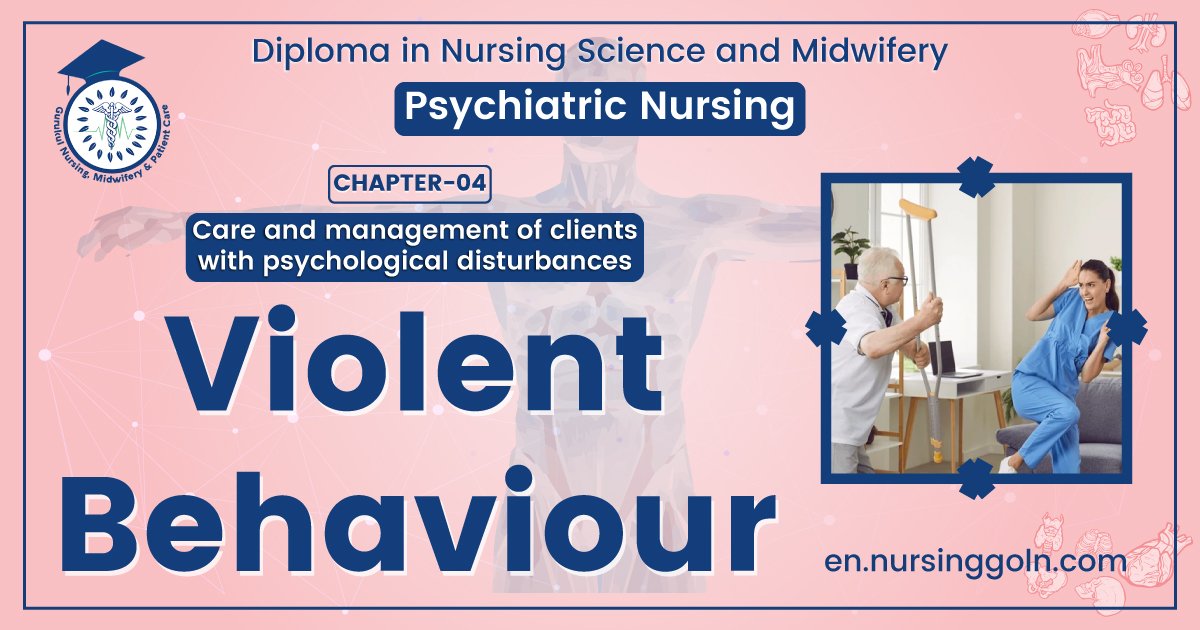Violent behaviour – This book covers the entire syllabus of “Psychiatric Nursing” prescribed by the Universities of Bangladesh- for Basic and diploma nursing students. We tried to accommodate the latest information and topics. This book is an examination-friendly setup according to the teachers’ lectures and examination questions.
At the end of the book previous university questions are given. We hope in touch with the book students’ knowledge will be upgraded and flourish. The unique way of presentation may make your reading of the book a pleasurable experience.

Violent behaviour
Violent Behavior in Children
Depending on the age of the child, violent behavior: can range from hitting, kicking, and biting, to hurting animals, and criminal acts like arson. Violent behavior is destructive behavior and can lead to severe consequences if left unmanaged. Many different factors that children are exposed to can increase the tendency for violent behavior.
Causes of Violence in Children
- Children who behave in a violent manner often have an underlying problem that is contributing to this aggressive behavior. Some identified causes of violent behavior include:
- Exposure to abuse physical, verbal, or sexual
- Neglectful parenting parents that don’t supervise children or provide a supportive home environment
- Emotional trauma and stress being exposed to a traumatic event or experiencing constant stress can cause violent outbursts
- Bullying being a bully or being a bullying victim
- Family history of violence some medical research indicates there is a genetic link that can predispose someone to violent behavior
- Substance abuse – alcohol and other illegal substances can predispose children to aggression
- Watching violence in the media watching violent programming on television can encourage violence
- The presence of weapons in the home having access to guns, crossbows, knives, etc. can make a child prone to using these weapons
- Playing violent video games first-person shooter games are often very realistic
- Mental health conditions ADD, ADHD, bi-polar disorder, and anxiety are just some of the mental health conditions that can contribute to violent outbursts and behavior
Warning Signs of Violent Behavior in Children
Experts warn that consistent violent behavior at any age should not be ignored. Some of the warning signs of violent behavior in children include.
- Frequent episodes of uncontrolled rage
- Fasily experiencing frustration
- Being very sensitive and irritable
- Frequently acting impulsively
- Frequently soiling the bed

Steps for nursing managing of aggressive/violent behaviour:
1. A Minimal stimulating environinent (Noise or light) and single room has to be provided clese to the nurse’s station for vigilant observation.
2. Limit interaction of the client with others.
3. Have essential things in client’s room, avoid sharp instruments, items, glass pieces or items; knives, ties, open circuits, match boxes, rope etc. in client’s vicinity.
4. Avoid to keep hazardous or toxic agents in the client’s room.
5. Stay with the client, approach him gently and with kind, allow him to talk, encourage him to interact without any inhibitions, show concern, establish therapeutie interpersonal relationship, assure him etc. all these factors will enhance security to the client.
6. Collect history carefully both from the client and his support system.
7. Carry out complete physical examination to exclude physical illness.
8. Try to explore the probable predisposing or underlying causes like H/O epileptic attacks, recent failure, stressor or facts.
9. Loss or death, grief reaction, alcoholism or drug abuse, fluctuations in level of consciousness; recent family disruptions etc. and plan the care accordingly.
10. Nurses have to follow self-protective measures, when they are with the client, e.g. never leave the client alone, unarm the client, keep someone nearer to you, assert authority, if need arises like not talking, refusing medications, aggressive behaviour still exists restraints may be necessary. Do not keep any potential instruments near tothe client, if client is having any weapon, ask them to keep on table or floor and wrap it with cloth instead of fighting to take it away from the client. If he is not listening, distract him for removing it.
11. Comfortable distance has to be maintained (stay at least arm’s length away from the client).
12. Prepare to move, as client can strike out suddenly.
13. Keep the doors open.
14. Maintain a clear exit route for both the staff and to the client.
15. Do not wear neck tie or jewellary.
16. Do not keep any provocative (family member or relative) individual near to the client. Do not sit close or back to the patient, do not confront with him.
17. Assist for prescribed or investigative procedures.
18. Encourage the client to redirect the behaviour with physical outlets, e.g. performing exercises, outdoor activities.
19. Motivate the client to ‘talk out’ rather than ‘acting out’

Physical Restraints
1. If the client is not talking out or rapport not established withholding himself or not taking drugs, behaving aggressively restraints may be necessary.
2. Approach the client form front.
3. A team of four members can hold each extremity of the client to tie-up with leather belts, padded bandages to restrain; talk to the client when team members are tying.
4. After restraining, do not leave the client unattended, e.g. observe the client 15 minutes once to ensure nutritional and elimination needs; any numbness, tingling or cyanosis in the extremities; choose the least restrictive alternative as far as possible.
5. Look for evidence of dehydration and malnutrition, supplement they need
6. Talk with the client softly; concise, direct; avoid asking closed ended questions
7. Talk to the client in direct. Firm, assertive manner
8. Offer food to the client to have calm effect and relieve clients anxiety and tension
9. Be supportive to the client and implement interventions
10. Promote self-esteem of the client
11. Avoid abusing the client, pointing, threading him, seeing very seriously, unnecessary promises etc.
12. When client condition improves, regains self-controls, teach alternative coping strategies to overcome aggressive behaviour and anxious or tensed up nature later.
[Ref: KP Neeraja/1/Vol-1/333-351
Read more:
